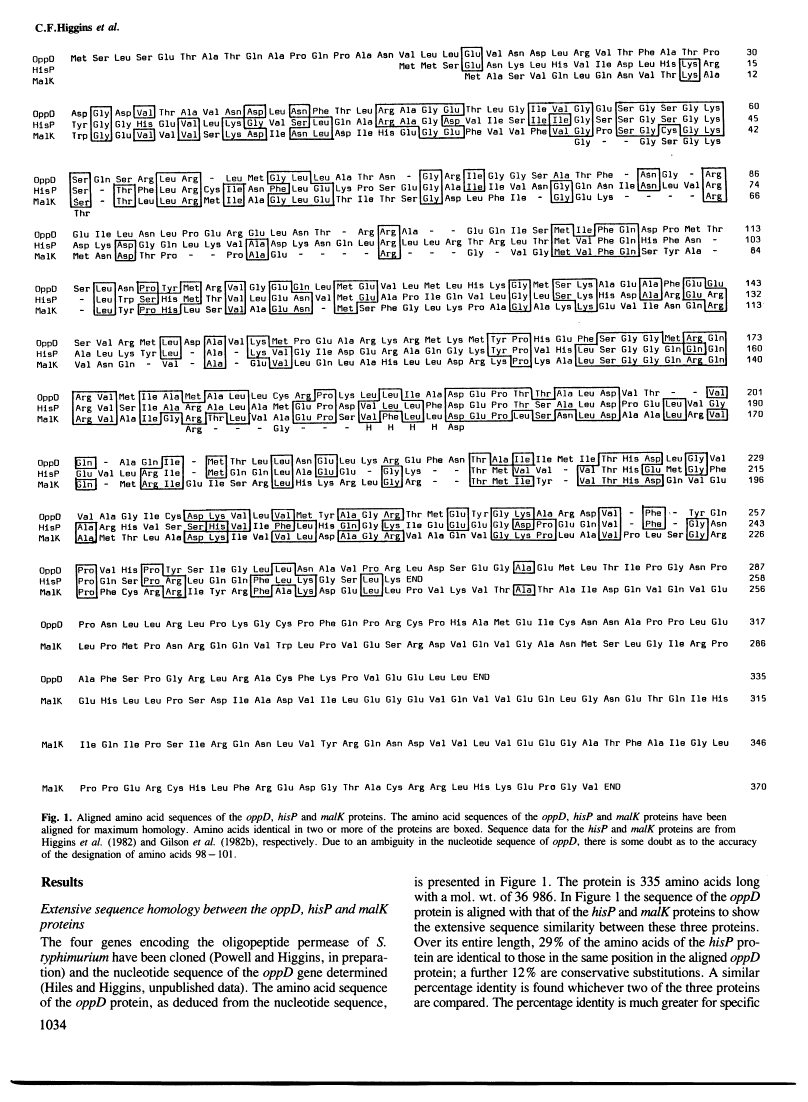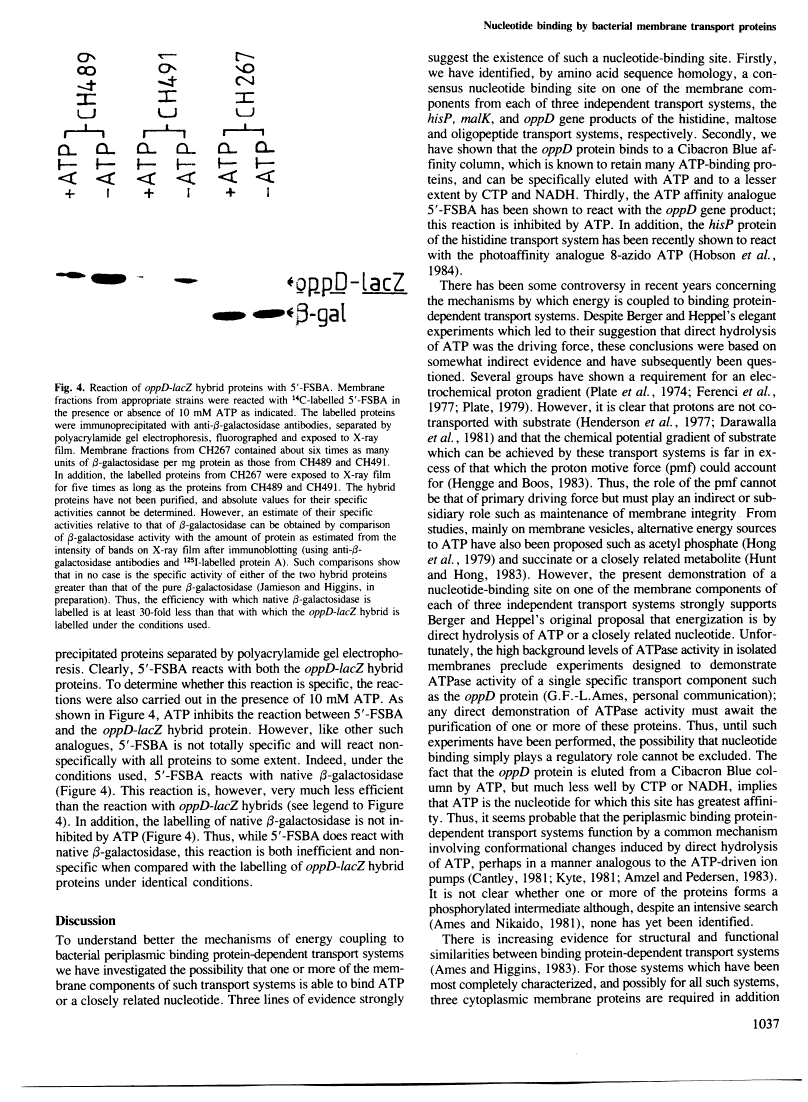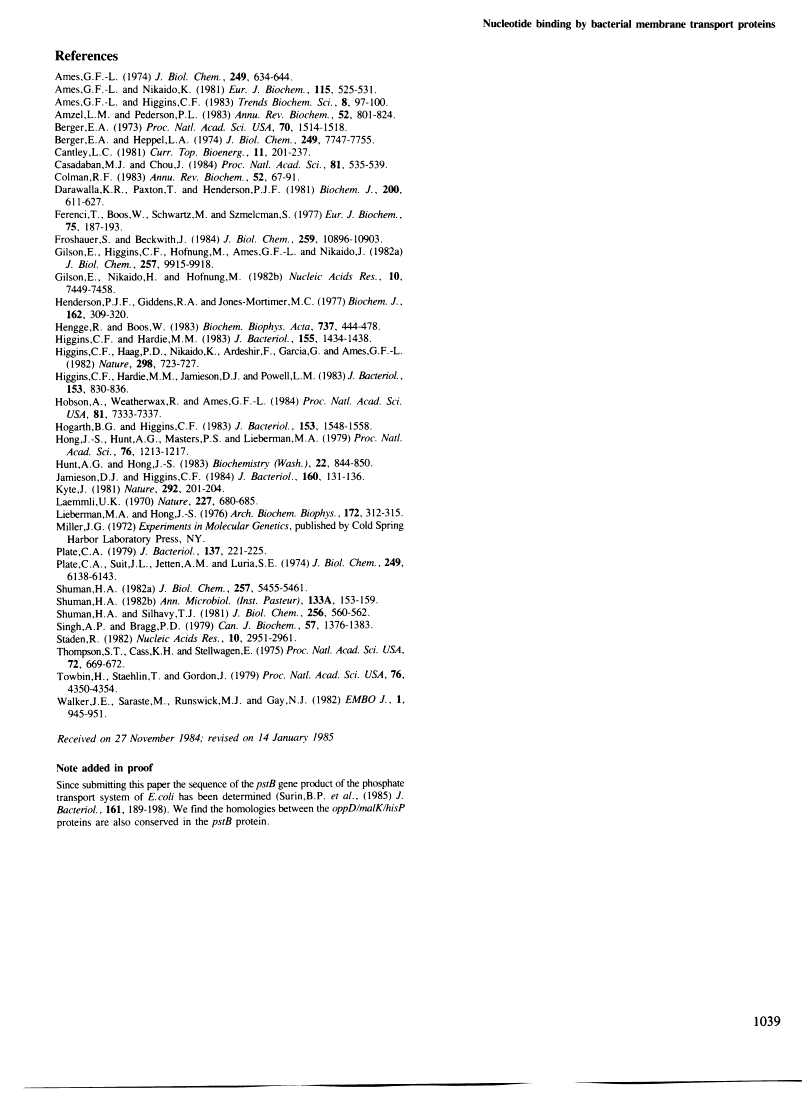Abstract
Free full text

Nucleotide binding by membrane components of bacterial periplasmic binding protein-dependent transport systems.
Abstract
Bacterial periplasmic binding protein-dependent transport systems require the function of a specific substrate-binding protein, located in the periplasm, and several membrane-bound components. We present evidence for a nucleotide-binding site on one of the membrane components from each of three independent transport systems, the hisP, malK and oppD proteins of the histidine, maltose and oligopeptide permeases, respectively. The amino acid sequence of the oppD protein has been determined and this protein is shown to share extensive homology with the hisP and malK proteins. Three lines of evidence lead us to propose the existence of a nucleotide-binding site on each of these proteins. A consensus nucleotide-binding sequence can be identified in the same relative position in each of the three proteins. The oppD protein binds to a Cibacron Blue affinity column and can be eluted by ATP but not by CTP or NADH. The oppD protein is labelled specifically by the nucleotide affinity analogue 5'-p-fluorosulphonylbenzoyladenosine. The identification of a nucleotide-binding site provides strong evidence that transport by periplasmic binding protein-dependent systems is energized directly by the hydrolysis of ATP or a closely related nucleotide. The hisP, malK and oppD proteins are thus responsible for energy-coupling to their respective transport systems.
Full text
Full text is available as a scanned copy of the original print version. Get a printable copy (PDF file) of the complete article (1.5M), or click on a page image below to browse page by page. Links to PubMed are also available for Selected References.
Images in this article
Selected References
These references are in PubMed. This may not be the complete list of references from this article.
- Ames GF. Resolution of bacterial proteins by polyacrylamide gel electrophoresis on slabs. Membrane, soluble, and periplasmic fractions. J Biol Chem. 1974 Jan 25;249(2):634–644. [Abstract] [Google Scholar]
- Ferro-Luzzi Ames G, Nikaido K. Phosphate-containing proteins of Salmonella typhimurium and Escherichia coli. Analysis by a new two-dimensional gel system. Eur J Biochem. 1981 Apr;115(3):525–531. [Abstract] [Google Scholar]
- Amzel LM, Pedersen PL. Proton atpases: structure and mechanism. Annu Rev Biochem. 1983;52:801–824. [Abstract] [Google Scholar]
- Berger EA. Different mechanisms of energy coupling for the active transport of proline and glutamine in Escherichia coli. Proc Natl Acad Sci U S A. 1973 May;70(5):1514–1518. [Europe PMC free article] [Abstract] [Google Scholar]
- Berger EA, Heppel LA. Different mechanisms of energy coupling for the shock-sensitive and shock-resistant amino acid permeases of Escherichia coli. J Biol Chem. 1974 Dec 25;249(24):7747–7755. [Abstract] [Google Scholar]
- Casadaban MJ, Chou J. In vivo formation of gene fusions encoding hybrid beta-galactosidase proteins in one step with a transposable Mu-lac transducing phage. Proc Natl Acad Sci U S A. 1984 Jan;81(2):535–539. [Europe PMC free article] [Abstract] [Google Scholar]
- Colman RF. Affinity labeling of purine nucleotide sites in proteins. Annu Rev Biochem. 1983;52:67–91. [Abstract] [Google Scholar]
- Daruwalla KR, Paxton AT, Henderson PJ. Energization of the transport systems for arabinose and comparison with galactose transport in Escherichia coli. Biochem J. 1981 Dec 15;200(3):611–627. [Europe PMC free article] [Abstract] [Google Scholar]
- Ferenci T, Boos W, Schwartz M, Szmelcman S. Energy-coupling of the transport system of Escherichia coli dependent on maltose-binding protein. Eur J Biochem. 1977 May 2;75(1):187–193. [Abstract] [Google Scholar]
- Froshauer S, Beckwith J. The nucleotide sequence of the gene for malF protein, an inner membrane component of the maltose transport system of Escherichia coli. Repeated DNA sequences are found in the malE-malF intercistronic region. J Biol Chem. 1984 Sep 10;259(17):10896–10903. [Abstract] [Google Scholar]
- Gilson E, Higgins CF, Hofnung M, Ferro-Luzzi Ames G, Nikaido H. Extensive homology between membrane-associated components of histidine and maltose transport systems of Salmonella typhimurium and Escherichia coli. J Biol Chem. 1982 Sep 10;257(17):9915–9918. [Abstract] [Google Scholar]
- Gilson E, Nikaido H, Hofnung M. Sequence of the malK gene in E.coli K12. Nucleic Acids Res. 1982 Nov 25;10(22):7449–7458. [Europe PMC free article] [Abstract] [Google Scholar]
- Henderson PJ, Giddens RA, Jones-Mortimer MC. Transport of galactose, glucose and their molecular analogues by Escherichia coli K12. Biochem J. 1977 Feb 15;162(2):309–320. [Europe PMC free article] [Abstract] [Google Scholar]
- Higgins CF, Hardie MM. Periplasmic protein associated with the oligopeptide permeases of Salmonella typhimurium and Escherichia coli. J Bacteriol. 1983 Sep;155(3):1434–1438. [Europe PMC free article] [Abstract] [Google Scholar]
- Higgins CF, Haag PD, Nikaido K, Ardeshir F, Garcia G, Ames GF. Complete nucleotide sequence and identification of membrane components of the histidine transport operon of S. typhimurium. Nature. 1982 Aug 19;298(5876):723–727. [Abstract] [Google Scholar]
- Higgins CF, Hardie MM, Jamieson D, Powell LM. Genetic map of the opp (Oligopeptide permease) locus of Salmonella typhimurium. J Bacteriol. 1983 Feb;153(2):830–836. [Europe PMC free article] [Abstract] [Google Scholar]
- Hobson AC, Weatherwax R, Ames GF. ATP-binding sites in the membrane components of histidine permease, a periplasmic transport system. Proc Natl Acad Sci U S A. 1984 Dec;81(23):7333–7337. [Europe PMC free article] [Abstract] [Google Scholar]
- Hogarth BG, Higgins CF. Genetic organization of the oligopeptide permease (opp) locus of Salmonella typhimurium and Escherichia coli. J Bacteriol. 1983 Mar;153(3):1548–1551. [Europe PMC free article] [Abstract] [Google Scholar]
- Hong JS, Hunt AG, Masters PS, Lieberman MA. Requirements of acetyl phosphate for the binding protein-dependent transport systems in Escherichia coli. Proc Natl Acad Sci U S A. 1979 Mar;76(3):1213–1217. [Europe PMC free article] [Abstract] [Google Scholar]
- Hunt AG, Hong J. Properties and characterization of binding protein dependent active transport of glutamine in isolated membrane vesicles of Escherichia coli. Biochemistry. 1983 Feb 15;22(4):844–850. [Abstract] [Google Scholar]
- Jamieson DJ, Higgins CF. Anaerobic and leucine-dependent expression of a peptide transport gene in Salmonella typhimurium. J Bacteriol. 1984 Oct;160(1):131–136. [Europe PMC free article] [Abstract] [Google Scholar]
- Kyte J. Molecular considerations relevant to the mechanism of active transport. Nature. 1981 Jul 16;292(5820):201–204. [Abstract] [Google Scholar]
- Laemmli UK. Cleavage of structural proteins during the assembly of the head of bacteriophage T4. Nature. 1970 Aug 15;227(5259):680–685. [Abstract] [Google Scholar]
- Lieberman MA, Hong JS. Energization of osmotic shock-sensitive transport systems in Escherichia coli requires more than ATP. Arch Biochem Biophys. 1976 Jan;172(1):312–315. [Abstract] [Google Scholar]
- Plate CA. Requirement for membrane potential in active transport of glutamine by Escherichia coli. J Bacteriol. 1979 Jan;137(1):221–225. [Europe PMC free article] [Abstract] [Google Scholar]
- Plate CA, Suit JL, Jetten AM, Luria SE. Effects of colicin K on a mutant of Escherichia coli deficient in Ca 2+, Mg 2+-activated adenosine triphosphatase. J Biol Chem. 1974 Oct 10;249(19):6138–6143. [Abstract] [Google Scholar]
- Shuman HA. Active transport of maltose in Escherichia coli K12. Role of the periplasmic maltose-binding protein and evidence for a substrate recognition site in the cytoplasmic membrane. J Biol Chem. 1982 May 25;257(10):5455–5461. [Abstract] [Google Scholar]
- Shuman HA. The maltose-maltodextrin transport system of Escherichia coli. Ann Microbiol (Paris) 1982 Jan;133A(1):153–159. [Abstract] [Google Scholar]
- Shuman HA, Silhavy TJ. Identification of the malK gene product. A peripheral membrane component of the Escherichia coli maltose transport system. J Biol Chem. 1981 Jan 25;256(2):560–562. [Abstract] [Google Scholar]
- Singh AP, Bragg PD. The action of tributyltin chloride on the uptake of proline and glutamine by intact cells of Escherichia coli. Can J Biochem. 1979 Dec;57(12):1376–1383. [Abstract] [Google Scholar]
- Staden R. An interactive graphics program for comparing and aligning nucleic acid and amino acid sequences. Nucleic Acids Res. 1982 May 11;10(9):2951–2961. [Europe PMC free article] [Abstract] [Google Scholar]
- Thompson ST, Cass KH, Stellwagen E. Blue dextran-sepharose: an affinity column for the dinucleotide fold in proteins. Proc Natl Acad Sci U S A. 1975 Feb;72(2):669–672. [Europe PMC free article] [Abstract] [Google Scholar]
- Towbin H, Staehelin T, Gordon J. Electrophoretic transfer of proteins from polyacrylamide gels to nitrocellulose sheets: procedure and some applications. Proc Natl Acad Sci U S A. 1979 Sep;76(9):4350–4354. [Europe PMC free article] [Abstract] [Google Scholar]
- Walker JE, Saraste M, Runswick MJ, Gay NJ. Distantly related sequences in the alpha- and beta-subunits of ATP synthase, myosin, kinases and other ATP-requiring enzymes and a common nucleotide binding fold. EMBO J. 1982;1(8):945–951. [Europe PMC free article] [Abstract] [Google Scholar]
Associated Data
Articles from The EMBO Journal are provided here courtesy of Nature Publishing Group
Full text links
Read article at publisher's site: https://doi.org/10.1002/j.1460-2075.1985.tb03735.x
Read article for free, from open access legal sources, via Unpaywall:
https://onlinelibrary.wiley.com/doi/pdfdirect/10.1002/j.1460-2075.1985.tb03735.x
Citations & impact
Impact metrics
Citations of article over time
Article citations
Emerging roles for ABC transporters as virulence factors in uropathogenic Escherichia coli.
Proc Natl Acad Sci U S A, 121(16):e2310693121, 12 Apr 2024
Cited by: 0 articles | PMID: 38607934 | PMCID: PMC11032443
Cloning and expression of selected ABC transporters from the Arabidopsis thaliana ABCG family in Pichia pastoris.
PLoS One, 14(1):e0211156, 18 Jan 2019
Cited by: 7 articles | PMID: 30657786 | PMCID: PMC6338384
Identification of the ATPase Subunit of the Primary Maltose Transporter in the Hyperthermophilic Anaerobe Thermotoga maritima.
Appl Environ Microbiol, 83(18):e00930-17, 31 Aug 2017
Cited by: 7 articles | PMID: 28687653 | PMCID: PMC5583491
ATP-Binding Cassette (ABC) Transporters of the Human Respiratory Tract Pathogen, Moraxella catarrhalis: Role in Virulence.
PLoS One, 11(7):e0158689, 08 Jul 2016
Cited by: 21 articles | PMID: 27391026 | PMCID: PMC4938438
Mycobacterium tuberculosis cell division protein, FtsE, is an ATPase in dimeric form.
Protein J, 34(1):35-47, 01 Feb 2015
Cited by: 10 articles | PMID: 25511207
Go to all (130) article citations
Data
Similar Articles
To arrive at the top five similar articles we use a word-weighted algorithm to compare words from the Title and Abstract of each citation.
The nucleotide-binding site of HisP, a membrane protein of the histidine permease. Identification of amino acid residues photoaffinity labeled by 8-azido-ATP.
J Biol Chem, 265(32):19535-19542, 01 Nov 1990
Cited by: 9 articles | PMID: 2246240
Characterization of the structural requirements for assembly and nucleotide binding of an ATP-binding cassette transporter. The maltose transport system of Escherichia coli.
J Biol Chem, 268(31):23685-23696, 01 Nov 1993
Cited by: 44 articles | PMID: 8226895
Extensive homology between membrane-associated components of histidine and maltose transport systems of Salmonella typhimurium and Escherichia coli.
J Biol Chem, 257(17):9915-9918, 01 Sep 1982
Cited by: 33 articles | PMID: 7050111
Bacterial periplasmic permeases belong to a family of transport proteins operating from Escherichia coli to human: Traffic ATPases.
FEMS Microbiol Rev, 6(4):429-446, 01 Aug 1990
Cited by: 101 articles | PMID: 2147378
Review













